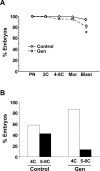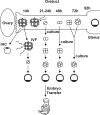Neonatal exposure to genistein disrupts ability of female mouse reproductive tract to support preimplantation embryo development and implantation
- PMID: 19005167
- PMCID: PMC2677916
- DOI: 10.1095/biolreprod.108.073171
Neonatal exposure to genistein disrupts ability of female mouse reproductive tract to support preimplantation embryo development and implantation
Abstract
Female mice treated neonatally with the phytoestrogen genistein (50 mg/kg/day) have multioocyte follicles, lack regular estrous cyclicity, and are infertile even after superovulation. To determine the cause of their infertility, we examined oocyte developmental competence and timing of embryo loss. Eggs obtained by superovulation of genistein-treated or control females were equally capable of being fertilized in vitro and cultured to the blastocyst stage. However, if eggs were fertilized in vivo, retrieved at the pronucleus stage, and cultured, there was a significant reduction in the percentage of embryos from genistein-treated females reaching the blastocyst stage. When these blastocysts were transferred to pseudopregnant recipients, the number of live pups produced was similar to that in controls. Preimplantation embryo development in vivo was examined by flushing embryos from the oviduct and/or uterus. Similar numbers of one-cell and two-cell embryos were obtained from genistein-treated and control females. However, significantly fewer embryos (<50%) were obtained from genistein-treated females on postcoital Days 3 and 4. To determine if neonatal genistein treatment altered the ability of the uterus to support implantation, blastocysts from control donors were transferred to control and genistein-treated pseudopregnant recipients. These experiments demonstrated that genistein-treated females are not capable of supporting normal implantation of control embryos. Taken together, these results suggest that oocytes from mice treated neonatally with genistein are developmentally competent; however, the oviductal environment and the uterus have abnormalities that contribute to the observed reproductive failure.
Figures




Similar articles
-
Neonatal phytoestrogen exposure alters oviduct mucosal immune response to pregnancy and affects preimplantation embryo development in the mouse.Biol Reprod. 2012 Jul 1;87(1):10, 1-10. doi: 10.1095/biolreprod.112.099846. Print 2012 Jul. Biol Reprod. 2012. PMID: 22553218 Free PMC article.
-
Blastocyst's state of activity determines the "window" of implantation in the receptive mouse uterus.Proc Natl Acad Sci U S A. 1993 Nov 1;90(21):10159-62. doi: 10.1073/pnas.90.21.10159. Proc Natl Acad Sci U S A. 1993. PMID: 8234270 Free PMC article.
-
Permanent oviduct posteriorization after neonatal exposure to the phytoestrogen genistein.Environ Health Perspect. 2011 Nov;119(11):1575-82. doi: 10.1289/ehp.1104018. Epub 2011 Aug 2. Environ Health Perspect. 2011. PMID: 21810550 Free PMC article.
-
Circulating levels of genistein in the neonate, apart from dose and route, predict future adverse female reproductive outcomes.Reprod Toxicol. 2011 Apr;31(3):272-9. doi: 10.1016/j.reprotox.2010.10.001. Epub 2010 Oct 15. Reprod Toxicol. 2011. PMID: 20955782 Free PMC article. Review.
-
Studies of the effects of neonatal exposure to genistein on the developing female reproductive system.J AOAC Int. 2006 Jul-Aug;89(4):1189-96. J AOAC Int. 2006. PMID: 16918037 Review.
Cited by
-
The pros and cons of phytoestrogens.Front Neuroendocrinol. 2010 Oct;31(4):400-19. doi: 10.1016/j.yfrne.2010.03.003. Epub 2010 Mar 27. Front Neuroendocrinol. 2010. PMID: 20347861 Free PMC article. Review.
-
Regulator of G-protein signaling 2 (RGS2) suppresses premature calcium release in mouse eggs.Development. 2015 Aug 1;142(15):2633-40. doi: 10.1242/dev.121707. Epub 2015 Jul 9. Development. 2015. PMID: 26160904 Free PMC article.
-
Neonatal Genistein Exposure and Glucocorticoid Signaling in the Adult Mouse Uterus.Environ Health Perspect. 2018 Apr 5;126(4):047002. doi: 10.1289/EHP1575. Environ Health Perspect. 2018. PMID: 29624291 Free PMC article.
-
Natural Herbal Estrogen-Mimetics (Phytoestrogens) Promote the Differentiation of Fallopian Tube Epithelium into Multi-Ciliated Cells via Estrogen Receptor Beta.Molecules. 2021 Jan 30;26(3):722. doi: 10.3390/molecules26030722. Molecules. 2021. PMID: 33573260 Free PMC article.
-
Epigenetic changes with dietary soy in cynomolgus monkeys.PLoS One. 2011;6(10):e26791. doi: 10.1371/journal.pone.0026791. Epub 2011 Oct 25. PLoS One. 2011. PMID: 22046358 Free PMC article.
References
-
- Adlercreutz H, Yamada T, Wahala K, Watanabe S.Maternal and neonatal phytoestrogens in Japanese women during birth. Am J Obstet Gynecol 1999; 180: 737–743. - PubMed
-
- Lapcik O, Hill M, Hampl R, Wahala K, Adlercreutz H.Identification of isoflavonoids in beer. Steroids 1998; 63: 14–20. - PubMed
-
- Whitten PL, Lewis C, Russell E, Naftolin F.Potential adverse effects of phytoestrogens. J Nutr 1995; 125: 771S–776S. - PubMed
-
- Setchell KD, Zimmer-Nechemias L, Cai J, Heubi JE.Exposure of infants to phyto-oestrogens from soy-based infant formula. Lancet 1997; 350: 23–27. - PubMed
-
- Hoey L, Rowland IR, Lloyd AS, Clarke DB, Wiseman H.Influence of soya-based infant formula consumption on isoflavone and gut microflora metabolite concentrations in urine and on faecal microflora composition and metabolic activity in infants and children. Br J Nutr 2004; 91: 607–616. - PubMed
Publication types
MeSH terms
Substances
Grants and funding
LinkOut - more resources
Full Text Sources
Medical

